Introduction
Virtual Assistant Statistics: The virtual assistant market has seen remarkable growth in recent years, largely driven by advancements in artificial intelligence (AI) and natural language processing (NLP). This expansion is largely due to the growing adoption of virtual assistants in both consumer and enterprise sectors, offering key benefits such as improved productivity, cost savings, and round-the-clock availability.
AI-powered virtual assistants have revolutionized industries such as customer service, healthcare, finance, and e-commerce by automating repetitive tasks, enhancing user experiences, and supporting businesses in informed decision-making processes. With the increasing reliance on voice-activated devices, virtual assistants have become essential in daily life, enabling everything from home automation to personalized recommendations. The continued rise in demand for these assistants is further propelled by the integration of emerging technologies, such as machine learning and deep learning, which continue to drive innovation in the field.
Editor’s Choice
- Companies can reduce their costs by up to 78% by hiring a virtual assistant.
- By 2028, it is projected that 50% of the U.S. workforce will consist of virtual professionals.
- Around 13% of employees report being more productive when working remotely, and 59% of virtual assistants are employed on a full-time basis.
- 49% of companies hiring virtual assistants have a workforce of over 1,000 employees.
- More than 50% of employees work remotely for at least 2.5 days each week.
- The average age of virtual assistants is around 50, with 75% of them being over 40 years old.
- In 2022, the United States had approximately 285,028 active virtual assistants contributing to various business operations.
- The virtual assistant workforce in the United States is predominantly female, with women comprising 83% of the workforce as of 2023.
- Approximately 87.7% of virtual assistants are compensated on an hourly basis.
- The majority of virtual assistants, nearly 59%, are employed full-time.
- Virtual assistants’ monthly rates can range from $400 to $5,600.
- The Philippines remains the top choice for businesses seeking virtual assistant talent.
(Source: Average Value Help, YesAssistant LLC, Social Emergers)
Intelligent Virtual Assistant Market Size
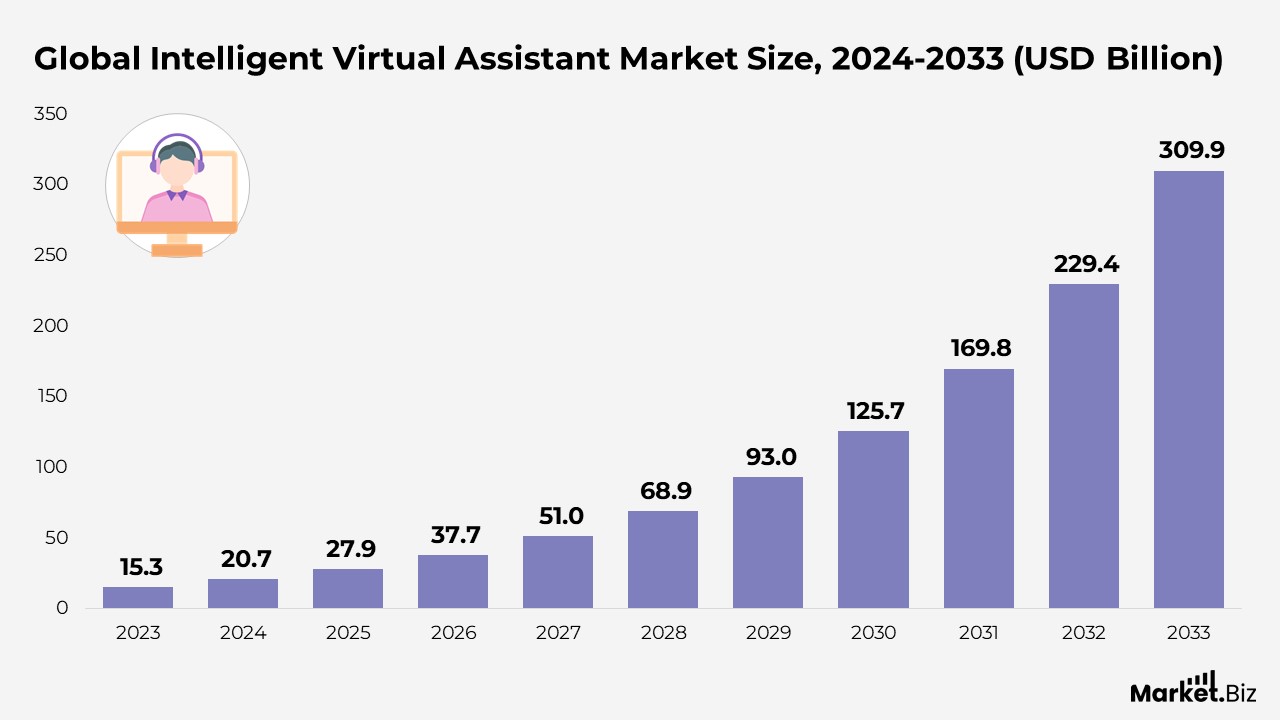
- According to Market.us, the global intelligent virtual assistant market is projected to grow from $27.9 billion in 2025 to $309.9 billion by 2033, representing a compound annual growth rate (CAGR) of 35.1% from 2024 to 2033.
- The intelligent virtual assistant (IVA) market is experiencing rapid growth as more businesses and consumers adopt IVAs for customer service, marketing, and operational support functions, driven by advancements in natural language processing, increased smartphone usage, and the demand for self-service options.
- In 2023, Chatbots dominated the IVA market, capturing over 70.6% of the market share due to their integration into customer service, e-commerce, and business operations.
- Text-to-speech technology represented more than 63.5% of the IVA market in 2023, enabling seamless user experiences by converting text into spoken words.
- The Consumer Electronics sector led the intelligent virtual assistant market in 2023, with a share of 21.2%, as IVAs are increasingly integrated into smartphones, smart speakers, and other consumer electronics.
- North America held the largest market share in 2023, accounting for 33.3% of the market, driven by its robust technological infrastructure and high consumer adoption of smart devices.
(Source: Market.us)
Medical Virtual Assistant Market Size
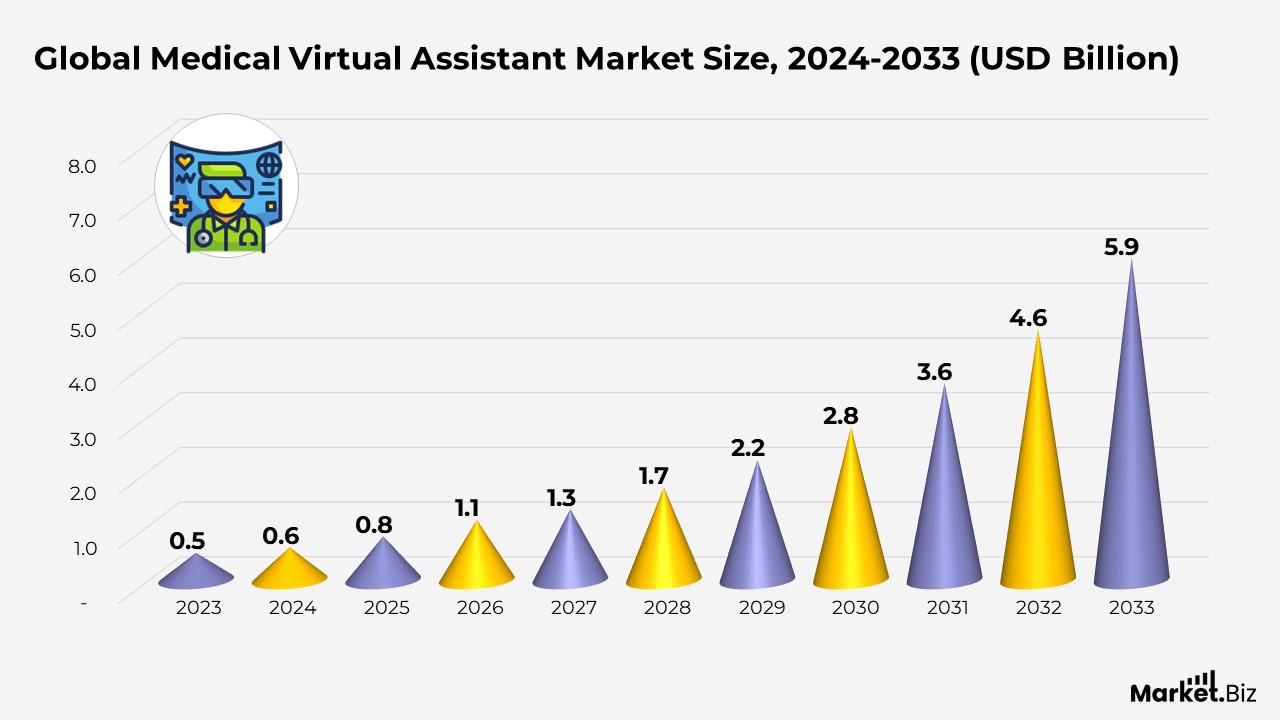
- According to Market.us, the global medical virtual assistant market is projected to grow from $0.5 billion in 2023 to $5.9 billion by 2033, representing a compound annual growth rate (CAGR) of 28.1% from 2023 to 2033.
- The growing popularity of telemedicine drives the medical virtual assistant market.
- The smart speakers segment led the market in 2023, capturing 62.4% of the market share, driven by the increasing adoption of voice-activated technologies in healthcare settings.
- Automatic speech recognition accounted for 53.7% of the market, addressing the growing demand for seamless voice interaction in healthcare.
- The healthcare providers segment experienced significant growth, with a revenue share of 48.9%, as virtual assistants help streamline patient management and administrative tasks.
- North America led the market in 2023, accounting for 39.2% of the revenue share, driven by increasing demand for AI-powered solutions and the adoption of telemedicine.
(Source: Market.us)
General Virtual Assistant Statistics
- 59% of businesses cite cost savings as the primary reason for outsourcing work.
- Virtual assistants can help businesses reduce operating costs by as much as 78%.
- Nearly 30.9% of virtual assistants hold business degrees, making them highly valuable across various industries.
- A significant portion of virtual assistants previously worked as administrative assistants.
- 24% of small businesses outsource tasks to enhance operational efficiency.
- 91% of virtual assistants in the U.S. hold a college degree.
- By 2028, it is projected that 50% of the U.S. workforce will be virtual.
- More than 80% of corporations plan to adopt a more flexible workforce structure.
- Around 37% of small businesses use outsourcing for at least one of their business functions.
- Virtual assistants offer a potential 78% cost savings compared to full-time employees.
(Source: Net Fusion Technology Pty. Ltd., Zippia, Virtudesk, Best of Budgets, True list)
Virtual Assistant Job Satisfaction
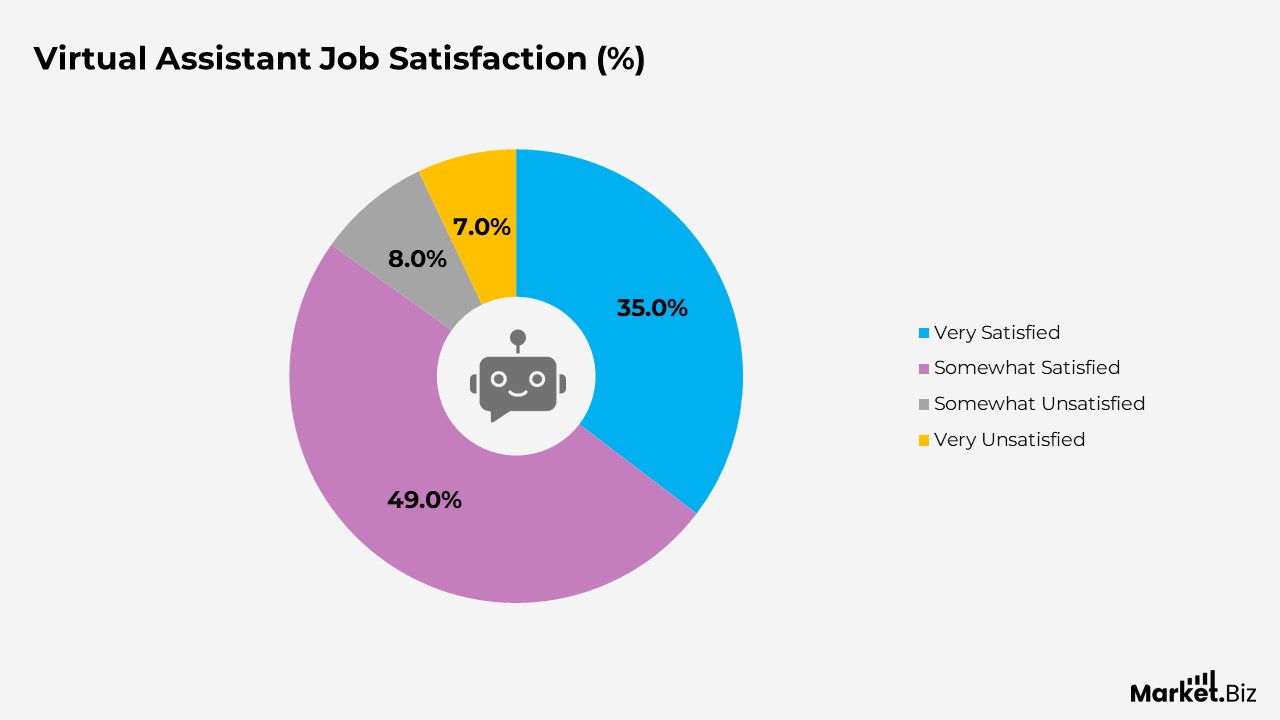
Popular Virtual Assistant Time Tracking Tools
- Toggl is the leading time-tracking tool used by 41.0% of respondents.
- 30.0% of users reported not using any time tracking tool.
- Clockify is preferred by 19.0% of users for tracking their time.
- 13.0% of participants use various other time tracking tools not specifically mentioned.
- Harvest is selected by 9.0% of users.
- Quickbooks Time is used by 6.0% of respondents.
- Everhour is favored by 1.0% of users.
- Hubstaff is also used by 1.0% of respondents.
- TimeCamp is chosen by 0.7% of users.
- Time Doctor is another tool used by 0.7% of respondents.
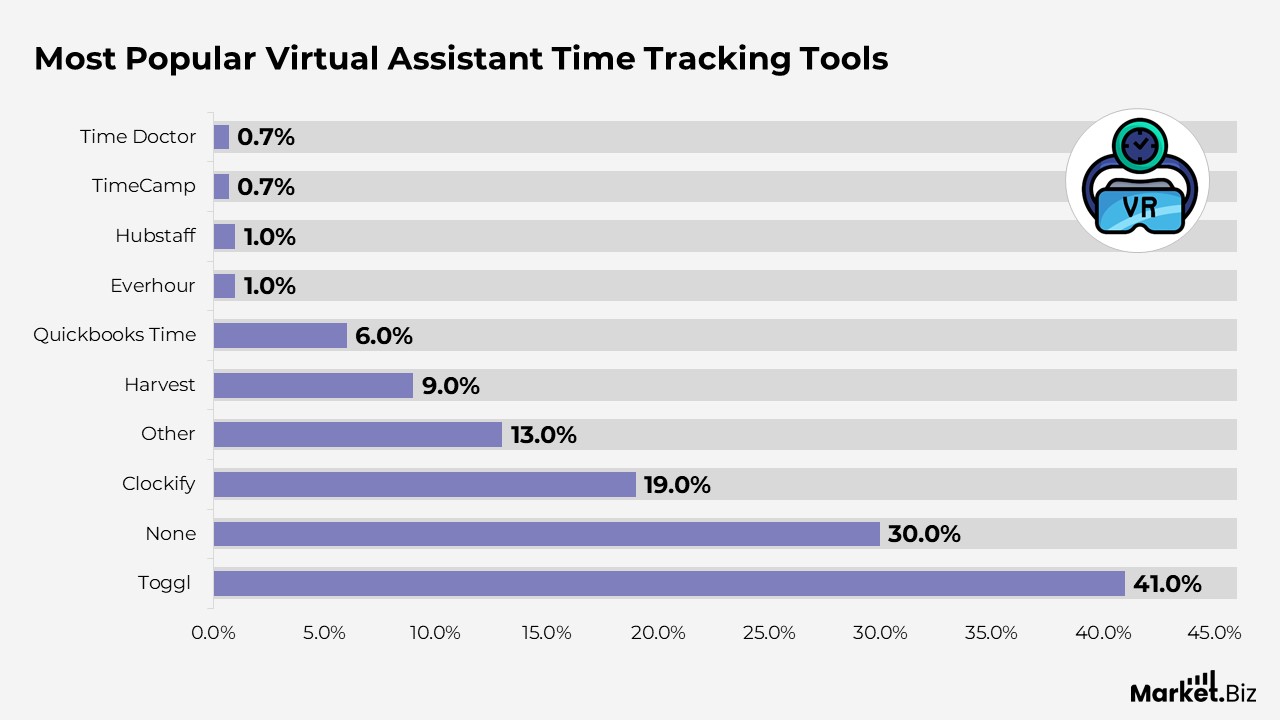
(Source: Inspiration Goods LLC)
Consumer Voice Assistant Adoption and Usage
- In a PwC survey of 1,000 U.S. adults aged 18 to 64, 10% were unfamiliar with voice-enabled devices. Among the 90% who were familiar with voice assistants, 72% had used one. Adoption is more prevalent among younger consumers, households with children, and those with incomes over $100k.
- Despite the widespread availability of voice assistants, 74% of users primarily access them at home. Focus group feedback highlighted a privacy preference when interacting with voice assistants and concerns about using them in public due to potential social awkwardness.
- This preference for home use may explain the lower usage among individuals aged 18 to 24, who tend to spend more time outside their homes.
- 50% of survey respondents have recycled voice assistants for a variety of purchases, with an additional 25% expressing attention to doing so in the future. Purchases completed through voice assistants are typically small, practical items that don’t require physical inspection for quality.
- Among those who have made voice-assisted purchases, 80% report high satisfaction, which could drive increased loyalty and spending.
- A positive shopping experience often leads to enhanced loyalty, trust, and increased spending. On average, 80% of consumers who used voice assistants for shopping report satisfaction, which translates into the following outcomes:
- 39% made repeat purchases with the same retailer.
- 39% of shoppers shared their positive experiences with friends and family.
- 36% developed a more favorable view of the retailer.
- 24% increased their spending with the retailer.
- 46% of respondents expressed concern, stating, “I don’t trust my voice assistant to interpret and process my order accurately.”
- 45% indicated that they don’t trust or feel comfortable making payments through their voice assistant.
(Source: PwC)
Weekly Hours Saved by Virtual Assistants Using AI
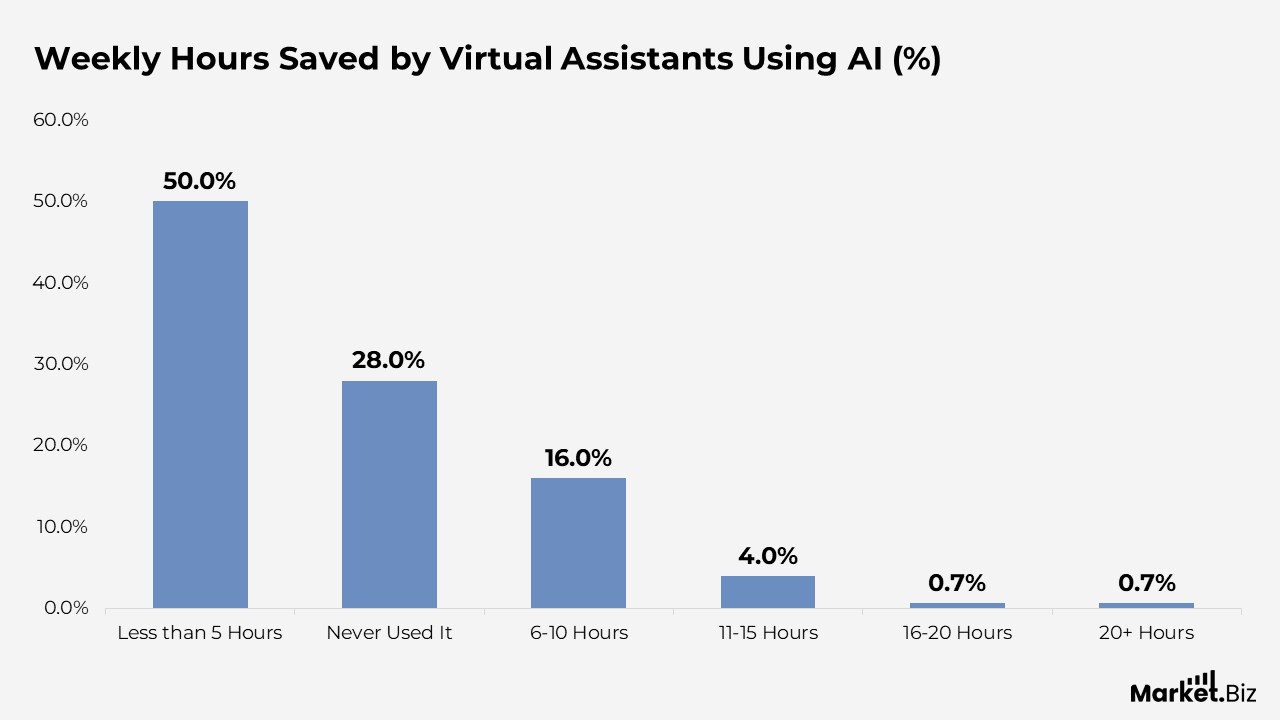
(Source: ProjectUntethered)
Key Industries Leveraging Virtual Assistants
- 20.5% of companies employ virtual assistants in marketing to streamline operations.
- 37.7% of businesses utilize virtual assistants for administrative tasks.
- 14% of businesses use virtual assistants for sales and prospecting activities.
- 9.7% of organizations rely on virtual assistants to improve operational workflows.
- 7.5% of organizations across other sectors also utilise virtual assistants to address diverse operational needs.
- 6.3% of enterprises integrate virtual assistants into customer service functions.
- 4.3% of businesses utilize virtual assistants for finance and bookkeeping tasks.
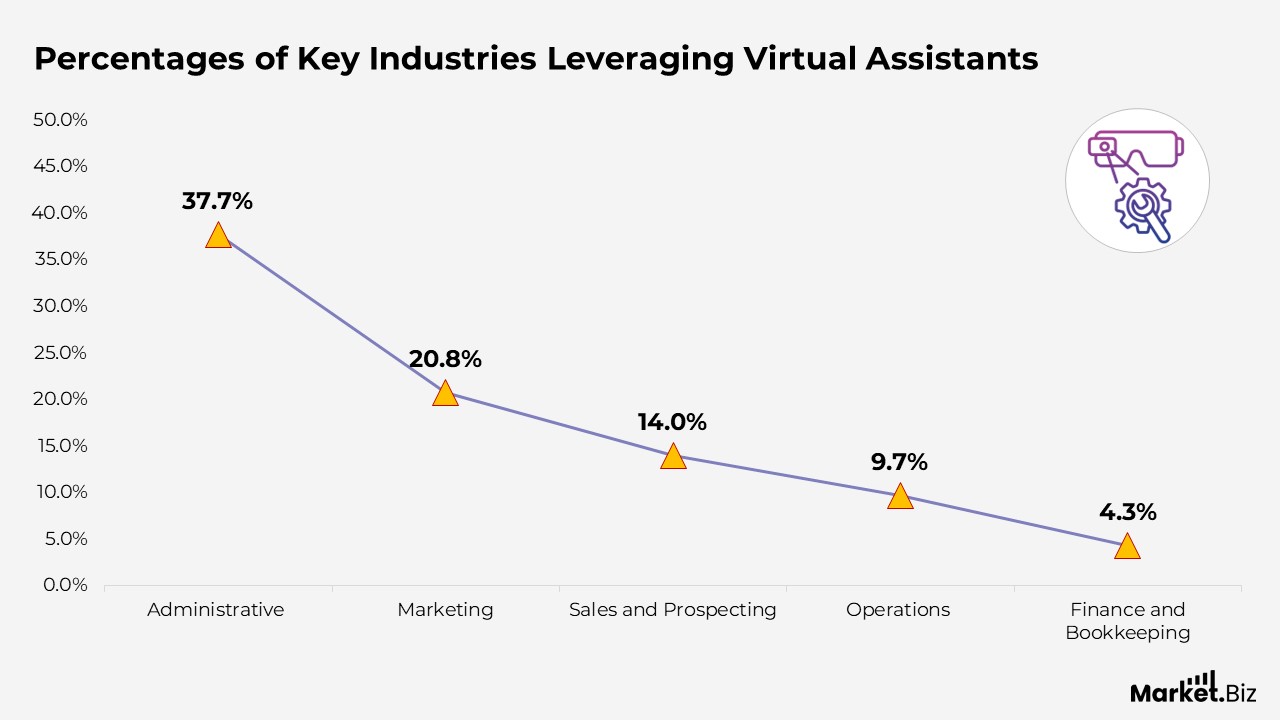
(Source: Virtudesk)
Integration of Virtual Assistants in Home Automation
- Virtual assistants have become a crucial component of home automation, as evidenced by survey results indicating widespread adoption across various devices.
- A notable 58% of respondents use virtual assistants with their televisions, indicating their seamless integration into entertainment systems.
- Lighting control is also popular, with 36% of participants using virtual assistants to adjust their lighting, thereby enhancing the overall ambience of their homes.
- In terms of environmental control, 29% of respondents utilize virtual assistants to control thermostats, promoting energy efficiency.
- Security is another area where virtual assistants are employed, with 26% of respondents integrating them into alarm systems.
- Additionally, 22% use virtual assistants to manage outlets and switches, highlighting their role in automating home functions.
- Even small smart appliances are being managed by virtual assistants, with 19% of users relying on them for convenience in daily tasks. Virtual assistants also play a role in home security, with 18% of users utilising them to control locks and garage doors. Finally, 16% of respondents have connected virtual assistants to their doorbell systems, further showcasing their versatile applications across various home devices.
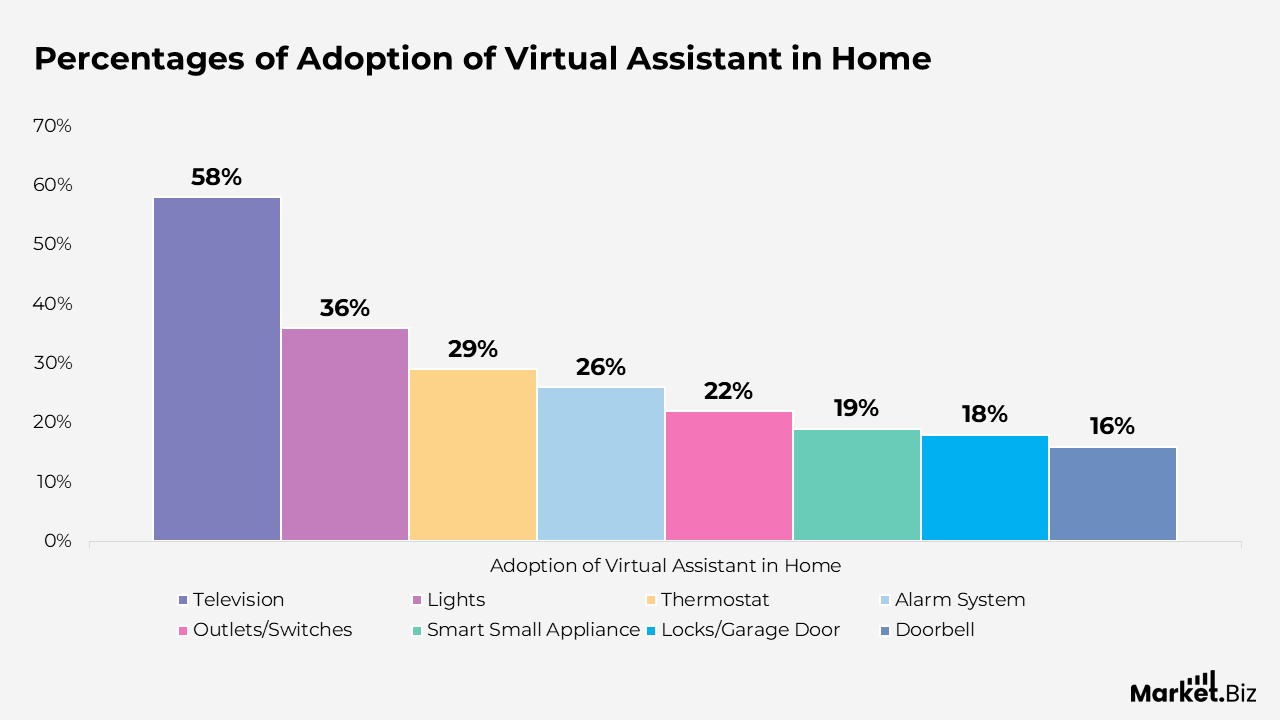
(Source: PwC)
Consumer Shopping Trends Through Virtual Assistant
- 34% of respondents have used voice assistants to purchase food or takeout meals.
- 31% have bought groceries through their voice assistants.
- 24% have made book purchases using voice assistants.
- 22% have used voice assistants to buy home care items and electronics.
- 21% have booked transportation services via voice assistants.
- 16% have made reservations through their voice assistants.
- 3% have purchased clothing using voice assistants.
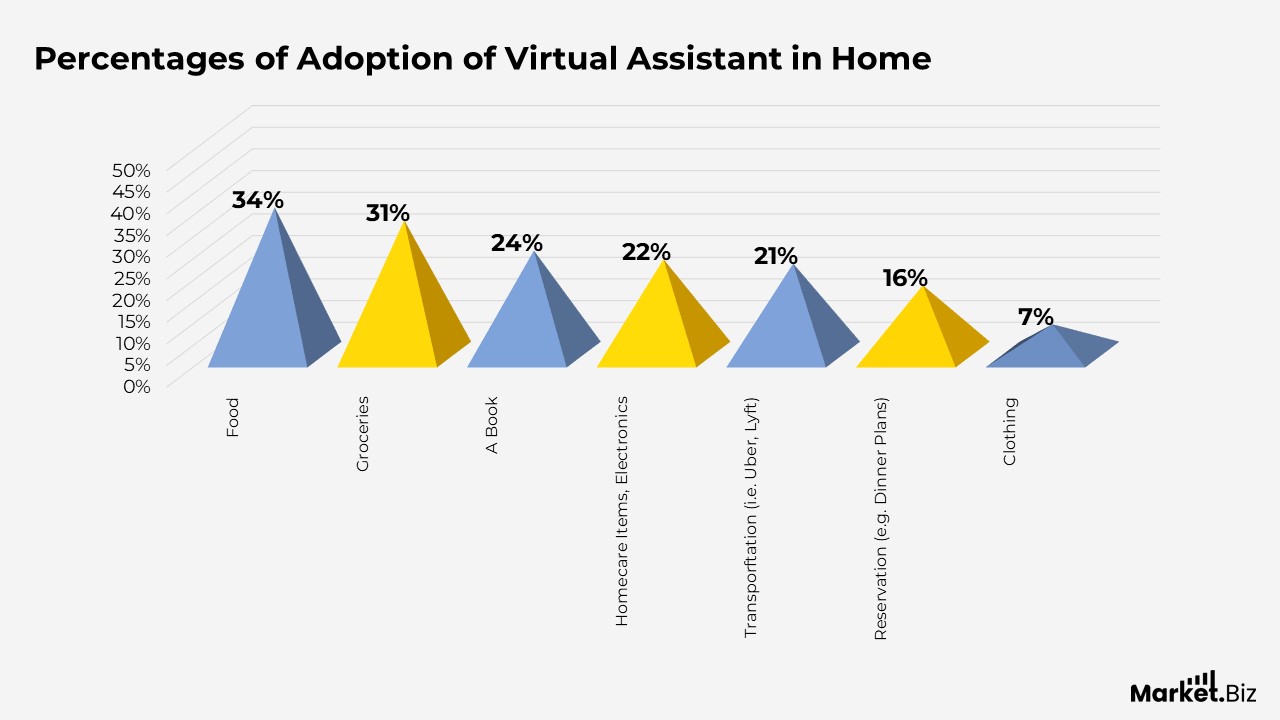
(Source: PwC)
Educational Background of Virtual Assistant Degree
By 2021, up to 60% of virtual assistants are expected to hold college degrees. Among them:
- 6% had had a master’s degree
- 45% had held a bachelor’s degree
- 8% had possessed an associate degree
- 24% had had other types of degrees
- 7% had had a high school diploma
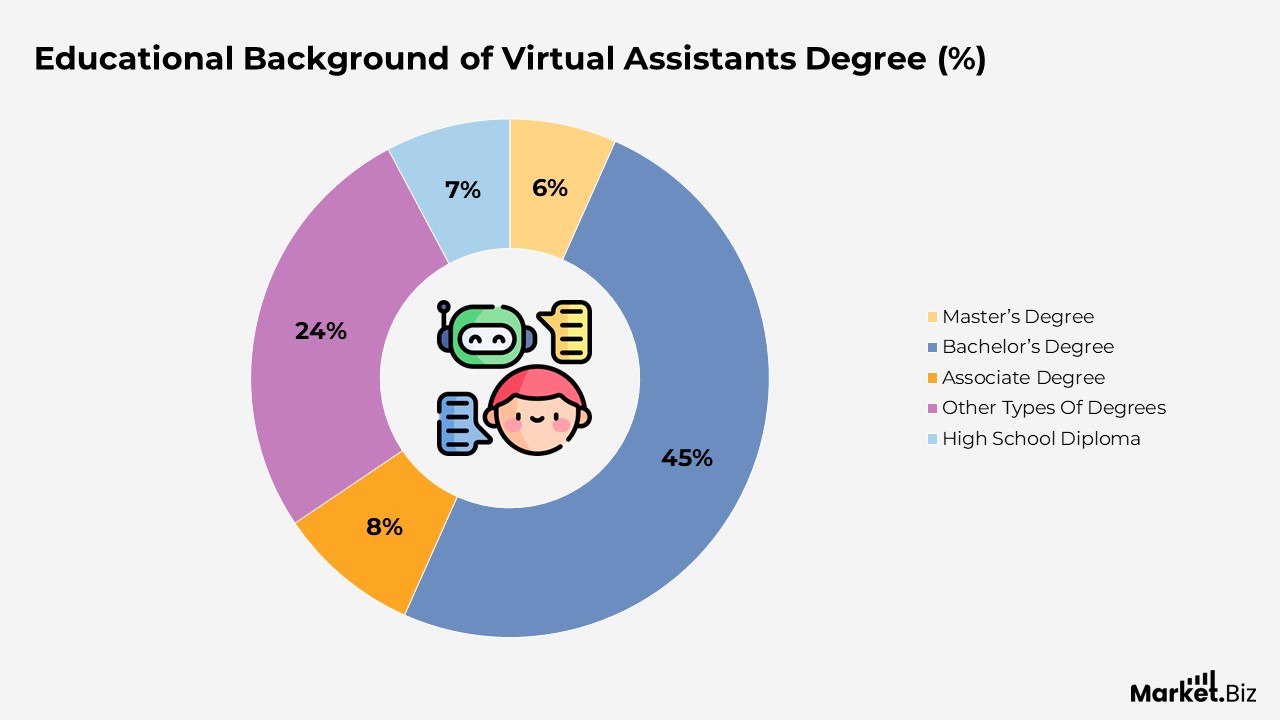
(Source: Zippia, Innovature BPO)
Virtual Assistant Salaries
- As per data from Indeed, the average hourly wage for a Virtual Assistant in the U.S. is $19.37, which translates to an annual salary of $58,344 in 2021.
- San Francisco leads the U.S. in compensation for virtual BPO services, offering salaries ranging from $60,875 to $92,483 annually in 2021.
- In contrast, India has the lowest percentage of Virtual Assistant hires, with wages ranging between $1 and $3 per hour ($3,000 annually).
- The average annual salary for a virtual assistant in the United States is approximately $39,915, with an average hourly wage of $19.19 as of 2024.
- Entry-level virtual assistants typically earn around $29,000 annually, with hourly rates generally ranging from $13 to $25.
- Virtual assistants in Hawaii, Washington, and Alaska receive the highest salaries, earning $53,760, $53,236, and $52,452, respectively.
- At IBM, virtual assistants are paid the highest salaries compared to other companies.
- In the U.S., virtual assistants are among the highest-paid professionals in their field.
- Approximately 87.7% of virtual assistants are compensated on an hourly basis, and 68% of freelance virtual assistants often juggle multiple employers, handle diverse tasks, or manage several contract projects simultaneously.
(Source: Innovature BPO, INSIDEA)
Costs of Hiring Administrative Virtual Assistants
- The U.S. Bureau of Labor Statistics (BLS) reports that the average annual salary for secretaries and administrative assistants is $46,010.
Additional costs include:
- On average, employees take seven paid sick days per year, which costs approximately $1,239.
- Employees with fewer than five years of experience typically receive 11 paid vacation days, totalling approximately $1,947.
- Each U.S. employee typically occupies 150 square feet of office space. Based on the average office space cost of $37.66 per square foot, this results in an annual cost of $5,649 per employee.
- Mid-level quality office equipment, including a computer, desk, chair, and supplies, typically costs around $2,250.
- Companies with over 50 employees are typically required to offer insurance, although the specifics may vary by location.
(Source: U.S. Bureau of Labor Statistics (BLS), Inspiration Goods LLC, Project Untethered)
Virtual Assistant Statistics By Industry
- The majority of virtual assistants are employed in the tech industry, making it the leading sector for their utilization.
- Industries that frequently outsource work include Information Technology (IT), finance and accounting, and healthcare, reflecting a growing demand for virtual assistant services in these fields.
- Half of the RealTrends Top 10 Real Estate Teams, which comprise the highest-rated real estate professionals, have utilized virtual assistants sourced through MyOutDesk, showcasing their widespread adoption in the real estate industry.
- Approximately 30.9% of virtual assistants hold business degrees, which makes them valuable assets across various industries.
- The most common previous role for virtual assistants is administrative assistant, indicating their background in providing organizational and clerical support.
- Approximately 24% of small businesses opt to outsource tasks to improve their operational efficiency, thereby driving further demand for virtual assistants.
- 40% of digital marketing agencies depend on virtual assistants to manage their campaigns.
- 35% of e-commerce businesses utilize virtual assistants for conducting product research.
- Approximately 30% of customer support companies utilise virtual assistants to manage their day-to-day operations.
- 22% of real estate agents delegate property listings to virtual assistants.
- 18% of healthcare organizations rely on virtual assistants to manage patient scheduling and insurance claims.
- Approximately 11% of law firms utilise virtual assistants for paralegal duties and case research.
(Source: Doxatalent, Zippia, MyOutDesk, LLC, MyOutDesk, Project Untethered, Virtual Coworker, Invedus, US Legal Support)
Demographics of Virtual Assistants
Race
- White virtual assistants represent the majority, comprising 70.8% of the total.
- Hispanic virtual assistants account for 14.8%, following white virtual assistants, but at a significantly lower rate.
- African American virtual assistants comprise 8.7% of the virtual assistant workforce.
- Asian virtual assistants represent 3.5% of the total.
(Source: Zippia, WebTribunal)
Gender
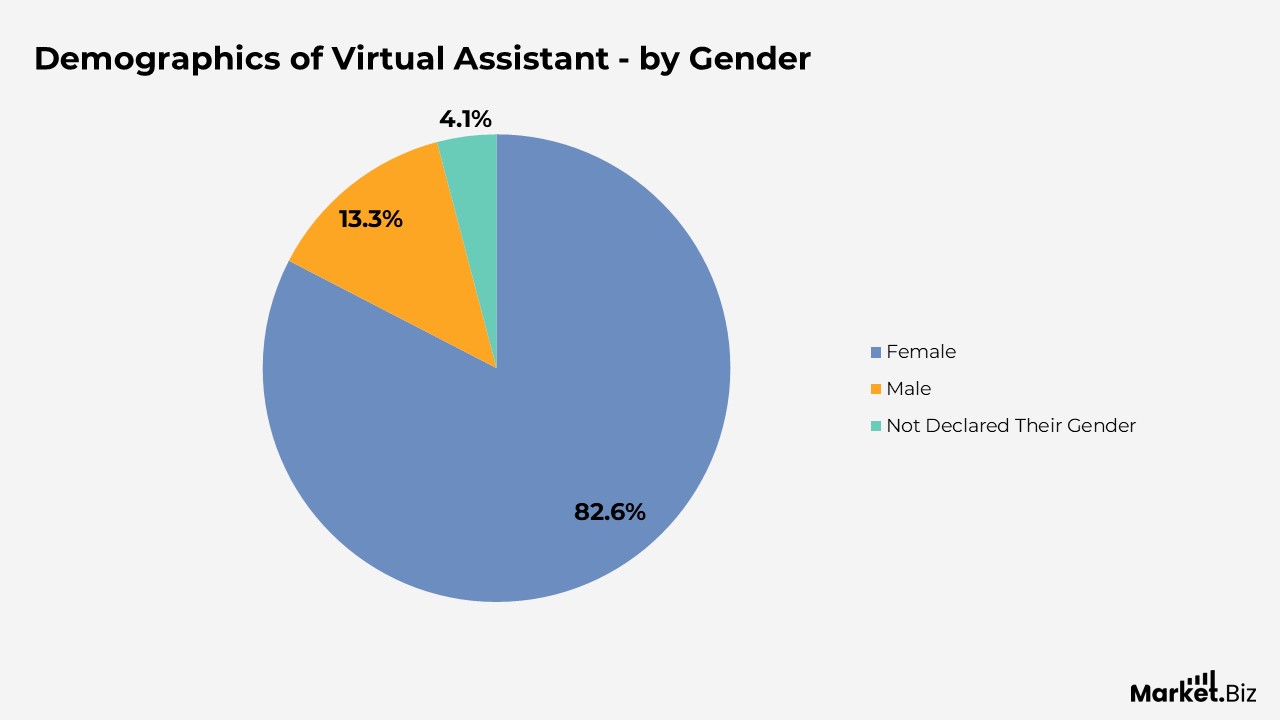
(Source: Zippia, WebTribunal)
Conclusion
The data on virtual assistants reveals notable patterns in terms of gender, race, and education. Women make up the majority of virtual assistants, outnumbering men in the field significantly. White individuals are the largest racial group using virtual assistants, followed by Hispanic, African American, and Asian users.
In terms of education, individuals with higher academic qualifications are more likely to adopt and utilise virtual assistant technologies. The use of virtual assistants distances a variety of sectors, from home automation to customer service, demonstrating their expanding role and adaptability. These findings underscore the increasing importance of virtual assistants as a valuable resource in both personal and professional contexts.
FAQ’s
The salary of a virtual assistant can vary depending on factors such as location, experience, and skill set. In the United States, the average hourly rate is approximately $19.37, translating to an annual income of around $ 40,888.
The majority of virtual assistants are female, with men making up a smaller portion of the field. Additionally, some virtual assistants choose not to disclose their gender.
White virtual assistants make up the largest group, followed by Hispanic, African American, and Asian virtual assistants. The remainder of the group consists of American Indians or individuals who haven’t declared their race.
Most virtual assistants have at least a high school diploma, with many holding bachelor’s or master’s degrees. Fewer virtual assistants have earned PhDs or other advanced degrees.
Virtual assistants are utilized in a wide range of industries, including customer service, administrative support, home automation, and personal assistance. They are gaining popularity in sectors like healthcare, retail, and finance.
Virtual assistants generally work remotely, serving clients from home offices. They are often hired by businesses and entrepreneurs to handle tasks such as administration, customer service, and scheduling.
Virtual assistants are responsible for a wide range of tasks, including managing calendars, responding to emails, scheduling appointments, overseeing social media accounts, providing customer support, and handling specialised duties such as data entry or managing e-commerce platforms.
